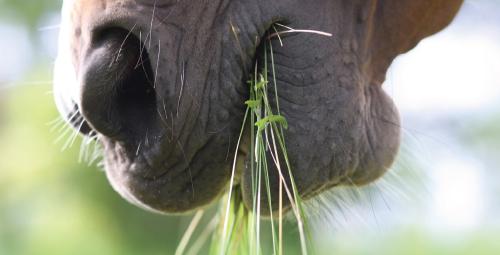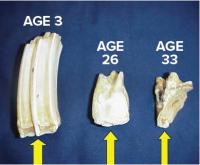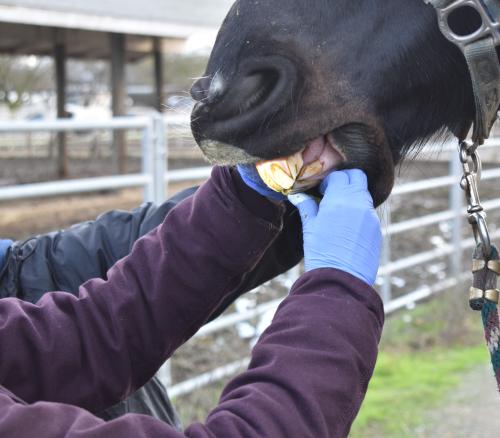Dental Care
A Crucial Aspect of Equine Longevity

As equine veterinary care advances, some of us are privileged to care for horses well into their sunset years. One important aspect of managing senior horses is caring for their teeth. Attention to oral health is essential to maintain proper nutrition.

Horses have hypsodont (high-crowned) teeth that continuously erupt from the gum line throughout life, allowing horses to maintain adequate grinding surfaces to break down forage. This characteristic also enables a rough estimation of a horse’s age based on the appearance of its teeth. As teeth wear down over time, the dental reserve crown becomes depleted. With increased lifespans, horses are beginning to “outlive” their teeth.
Fortunately, there are steps that owners can take to extend the life of their horses’ teeth. “Older horses can be transitioned to feed products with processed forage (complete feed, pellets, cubes, etc.) as their base, which makes eating and chewing easier,” said Dr. Nicola Pusterla, chief of the UC Davis Equine Dentistry and Oral Surgery Service. “Additionally, soaking feeds such as concentrates or cubes is a great way to increase hydration while simultaneously softening the feed.”
Even with softer foods and a complete pellet diet, many ailments associated with the horse’s mouth are overlooked. The mouth is the first organ in the digestive tract, so issues in the oral cavity can result in devastating consequences further down. It is important to have a veterinarian evaluate the horse’s mouth at least yearly; this can be coupled with a yearly physical exam. However, there are also many things to look for that are good indications that your horse needs to be seen by a veterinarian or equine dentist. “Prevention is always better than a cure,” said Pusterla.
One of the easiest ways to assess a horse’s dental health is to simply watch the horse eat! Determining the normal eating pattern and monitoring it over time can provide veterinarians with important information.
When watching your older horse eat, look for the following:
- Signs of abnormal chewing - Horses normally chew with the lower jaw moving in an oval-shaped motion as it grinds against the upper jaw. Changes to this pattern can indicate discomfort.
- Quidding - This occurs when horses appear to “spit up” their food. This is evident in the presence of a food bolus, or ball of forage, that the horse is unable to grind down and consume.
- Amount consumed - If your horse appears to be eating less than normal, losing weight, and/or you notice undigested long pieces of forage or grain in the feces, it could be an indication of dental problems.
- Discharge, bumps/lumps, draining tracts, excessive salivation, and bad breath - The presence of any of these could be an indication that something is wrong in the mouth and a thorough veterinary examination of the oral cavity is warranted.
Dental Diseases Commonly Associated with Geriatric Equines
As horses age, there is increased likelihood of damage and infection to the teeth and mouth. Damage to the tooth can vary from fractures to uneven grinding surfaces to infection. Damage to structures that support the tooth can result from accumulation of food in between teeth, causing inflammation of the gingiva and surrounding tissues. Foreign bodies, such as foxtails, can also damage soft tissues.
One particular disease that affects older horses is equine odontoclastic tooth resorption and hypercementosis (EOTRH). This disease mainly affects the incisors (front teeth), the canines, and occasionally the premolars (first few teeth that are part of the grinding surface). The exact mechanism of the disease is unknown. ”As the disease progresses, there is inflammation at the roots of the teeth, possibly as a result of the forces at play as older horses, with longer teeth, chew,” said Pusterla. “The inflammation triggers absorption of the root structures, which is the body’s way of responding to the insult.” Weakening of the root structures compromises tooth integrity. This results in an excessive production of cementum(hypercementosis), the outermost layer of the tooth that helps to protect and stabilize the tooth in the gum line. Hypercementosis commonly leads to the tooth fracturing due to its brittle nature, and often results in infection. Clinical signs of EOTRH include weight loss, inability to eat hard treats, head shyness, avoiding contact with the bit, quidding, and dullness.
The Center for Equine Health has supported research, led by Dr. Pusterla and Dr. Verena Affolter, to learn more about how EOTRH develops. A greater understanding of the underlying mechanisms of EOTRH could enable advances in dental care for older horses and may aid the development of future treatments.
Caring for the older horse population is becoming increasingly important. Yearly exams to monitor the comfort of senior horses is critical to providing healthy later chapters in a horse’s long, full life.

